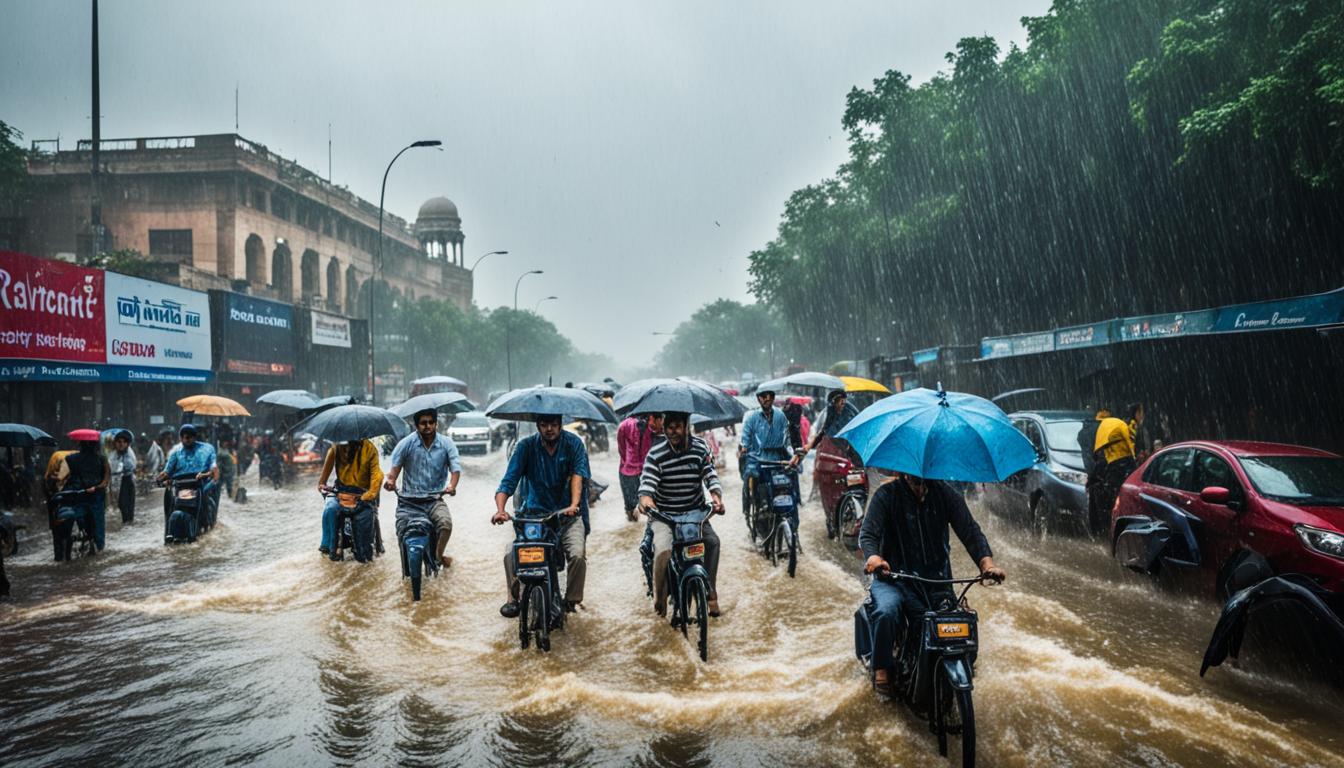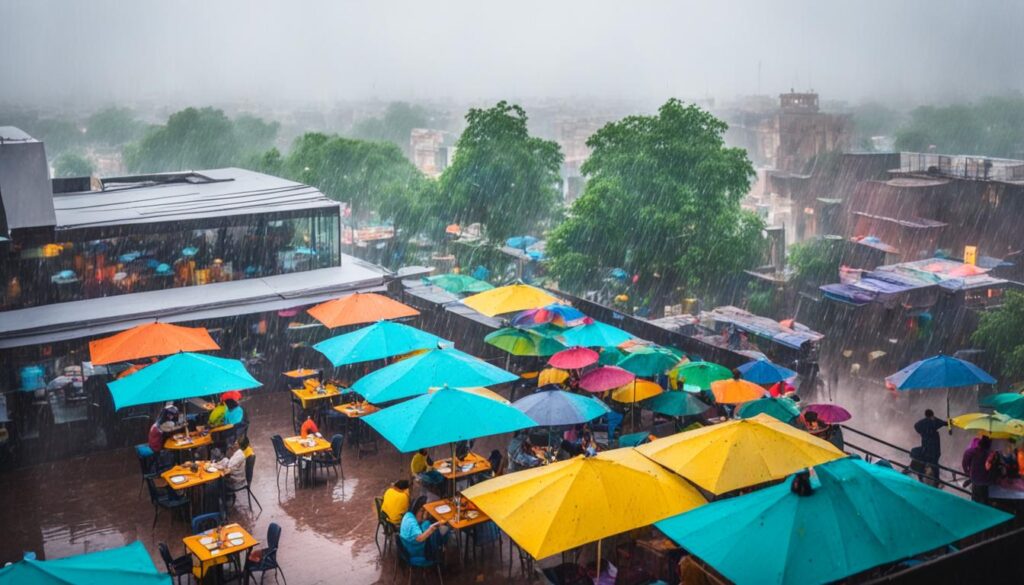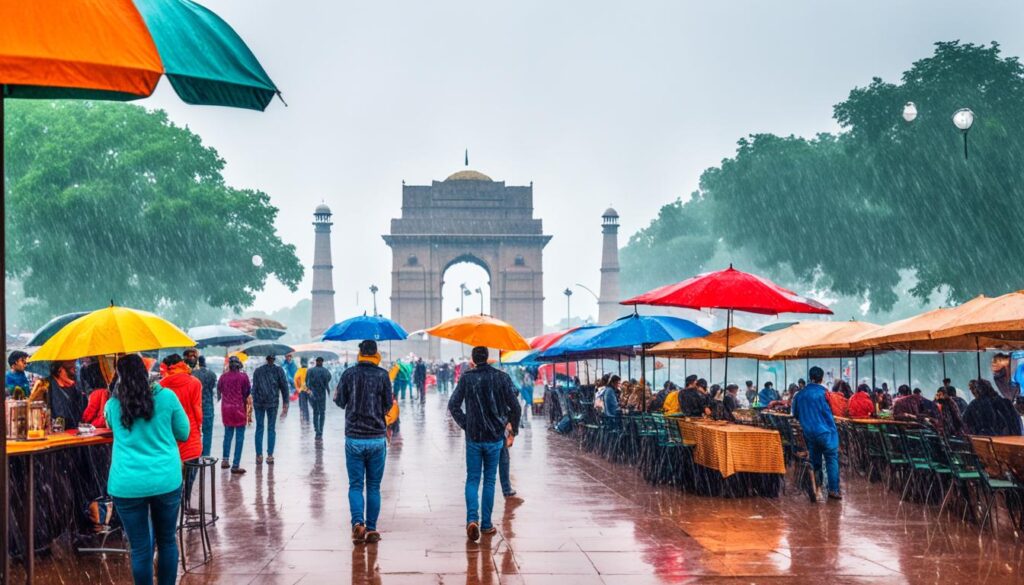
Monsoon in Delhi: Weather Insights & Tips
Did you know Delhi gets about 714mm of rain during the monsoon season? That’s almost the same as Manchester, UK. The monsoon cools the city down from the hot summer. It turns Delhi into a lush, green haven. In this piece, we’ll look at Delhi’s unique weather, the start of monsoon season, and tips for enjoying the city then. Let’s explore the wonders of Delhi’s monsoon together!
Delhi’s Unique Climate
Delhi’s weather changes a lot because of where it is and how far it is from the ocean. It sits by the River Yamuna, with the big Himalayas to the north. This means Delhi gets a mix of both a land climate and the humid, wet weather usual for the area. The result? Big temperature changes and different amounts of rain in winter and summer.
Winter in Delhi is pretty cool, with days hitting 21°C. Nights can get really cold, sometimes almost freezing, thanks to cold winds from the Himalayas. Winter mornings often bring mist and fog. This can lead to trouble with traffic.
Summer brings the heat and dryness, with daily highs in the mid-30s. Sometimes, it gets super hot, up to 45°C, making it tough for everyone in the city.
The city’s rain pattern also changes through the year. The rainy season starts in June and ends in September. It brings a lot of rain that fills up Delhi’s water places. With the rain comes lush greenery and cooler air, which makes the hot summer feel better.
Monsoon in Delhi
The monsoon season in Delhi cools down the summer heat and brings more humidity. Everyone looks forward to the arrival of refreshing rains. Delhi’s average yearly rainfall is similar to Manchester, UK, mostly poured out in July and August.
The monsoon starts around June 29th in Delhi. This marks the end of hot summer days. The India Meteorological Department expertly predicts when the rains will come. This helps locals and farmers plan ahead. Yet, the rainfall can vary, potentially causing droughts and affecting agriculture and water supplies.
Delhi has two weather stations that are key for accurate weather forecasts. Their data helps predict rainfall patterns and its effects on the area.
The monsoon transforms Delhi, making it lush and green. It creates stunning scenes for photos. After the rain, streets and parks become ideal spots for nature lovers and photographers.
“The monsoon season is a time of renewal and rejuvenation, filling the air with a sense of anticipation and joy.” – Anonymous
To stay dry during sudden showers, carrying an umbrella or raincoat helps. And it’s wise to wear shoes with good grip to avoid slipping.
The monsoon adds a special charm to Delhi. It’s a great time for street food and exploring. So, embrace the monsoon’s beauty and make lasting memories.
| Monsoon in Delhi | Key Information |
|---|---|
| Season Duration | Approximately 2 months |
| Peak Rainfall Months | July and August |
| Annual Rainfall | Similar to Manchester, UK (around 714mm) |
| Onset of Monsoon | Around June 29th |
| Weather Observing Stations | Two stations providing crucial data for weather predictions |
Exploring Delhi During Monsoon
The monsoon season in Delhi brings exciting activities and experiences. It’s perfect for food lovers, photography enthusiasts, or those seeking relaxation. Below are some tips to enjoy your monsoon visit:
1. Visit Rooftop Cafes
Delhi’s rooftop cafes are known for their vibrant dining scenes. In the monsoon, they become cozy spots for enjoying hot drinks. Imagine having your favorite coffee or tea, surrounded by a rain-washed city, with a cool breeze around. It’s an ideal rainy day activity in Delhi.
2. Capture the Beauty of Delhi Through Photography
Monsoon brings out Delhi’s lush greenery and vibrant colors, making it a dream for photographers. Take your camera and capture Delhi’s rainy essence. You’ll find a range of subjects, from monuments and markets to parks and neighborhoods. Don’t miss capturing these enchanting monsoon moments in the capital.
3. Indulge in Street Food Delights
Experiencing Delhi’s street food is a must. The monsoon makes it even more special with hot delicacies. Enjoy crispy pakoras, steaming momos, spicy chaat, and refreshing chuskis. Rain adds to the adventure of discovering Delhi’s street food flavors.
4. Take a City Tour Bus
Exploring Delhi’s attractions is easy with a city tour bus, especially in the monsoon. These buses let you see the city comfortably. Enjoy seeing Delhi’s beauty in the rain from the bus. It’s an easy way to see the city and make the most of your visit.
5. Relax in the Serene Parks of Delhi
Delhi’s parks turn into lush paradises in the monsoon. They offer a break from busy city life. Enjoy a walk, breathe the fresh air, and admire nature’s beauty. From Lodhi Gardens to the Garden of Five Senses, these parks provide a peaceful retreat during the rain.

Get into Delhi’s monsoon charm by visiting rooftop cafes, enjoying street food, taking photos, touring the city by bus, and relaxing in its parks. The monsoon season blends tranquility, vibrancy, and culinary delights, offering a memorable experience that reveals the city’s true spirit.
Best Time to Visit Delhi
Planning a trip to Delhi? It’s important to know the best time to visit. The ideal months are October and November, and February and March. These months offer pleasant weather, cooler temperatures, and lots of sunshine. It’s great for outdoor fun and exploring the city.
In October and November, Delhi’s weather is mild, with temperatures between 15°C (59°F) and 30°C (86°F). The city is bright and welcoming under the clear skies. It’s the perfect atmosphere for discovering Delhi’s famous sights.
February and March bring warmer days with temperatures from 10°C (50°F) to 25°C (77°F). This weather is great for enjoying Delhi’s outdoor spaces and cultural events. The evenings are especially nice, making it perfect for evening walks through gardens and markets.
Visiting during these months lets you enjoy Delhi to the fullest. Whether you’re looking to see historic sites, eat local foods, or dive into the culture, this is the best time to go.
Outdoor Activities
For outdoor lovers, the best months to visit offer many activities. Enjoy walks in Lodi Gardens or the stunning Mughal Gardens. The weather is just right for seeing the historic Old Delhi, including the Red Fort and Jama Masjid.

“Delhi beautifully merges history with modern times. Enjoying its heritage sites in October’s mild sun or March’s spring bloom is magical.”
Cultural Festivals
October and November in Delhi are full of cultural festivities. Experience the beauty of Diwali, the festival of lights, with dazzling streets and traditional ceremonies. February is special too, with Basant Panchami, celebrating the goddess Saraswati. The city buzzes with colorful celebrations and kite flying.
Shopping and Cuisine
Delhi’s markets and street food are famous. During October, November, February, and March, explore markets like Chandni Chowk and Sarojini Nagar. Shop for clothes, jewelry, and spices, and don’t miss the chaat and parathas.
Choose the best months for your Delhi trip to enjoy its cultural heritage, nice weather, festive events, and tasty food. Plan well to make the most of your visit.
| Month | Average Temperature (°C) | Average Rainfall (mm) |
|---|---|---|
| October | 15 – 30 | 8.8 |
| November | 12 – 26 | 4.2 |
| February | 9 – 24 | 12.8 |
| March | 15 – 30 | 9.1 |
Weather Precautions in Monsoon
In Delhi’s monsoon season, being safe and healthy is key. The rains and humidity bring challenges. Here are important tips and concerns for monsoon weather safety and health:
1. Be Prepared for Sudden Rainfall
Sudden showers are common in Delhi’s monsoon. Always carry an umbrella or raincoat to stay dry and avoid colds. Keep up with the weather forecasts to plan better.
2. Wear Appropriate Footwear
Monsoon makes surfaces wet and slippery, raising fall and injury risks. Choose footwear with good grip. Avoid open-toed or high-heeled shoes to reduce slipping chances.
3. Take Precautions for Health Concerns
Monsoon increases respiratory and waterborne disease risks. Here’s how to stay safe:
- Eat street food from clean, reliable places only to avoid food-borne illnesses.
- Always drink purified water and consider carrying your own bottle.
- Wash your hands often with soap and clean water for good hygiene.
- Stay out of damp, stuffy places to keep respiratory infections away.
4. Be Mindful of Mosquitoes
Mosquitoes thrive in the monsoon, raising the risk of diseases like dengue. Wear long sleeves, use repellents, and eliminate stagnant water to prevent breeding.
Keep these precautions in mind to stay safe and enjoy Delhi’s monsoon beauty.
| Monsoon Precautions | Weather Safety Tips | Monsoon Health Concerns |
|---|---|---|
| Be prepared for sudden rainfall | Carry an umbrella or raincoat | Avoid street food from unhygienic vendors |
| Wear appropriate footwear | Choose shoes with good traction | Drink clean, purified water |
| Take precautions for health concerns | Follow hygiene practices | Maintain personal hygiene |
| Be mindful of mosquitoes | Use mosquito repellents | Protect against mosquito-borne diseases |
Transportation Considerations in Monsoon
Traveling in Delhi during the monsoon can be tough. Heavy rain and fog often delay or cancel flights. It’s crucial for travelers to keep an eye on the weather and check transportation updates.
Trains in Delhi may also face issues due to flooded tracks. Travelers should be ready for delays or changes. They should also plan extra time for travel.
Despite these problems, safety comes first. It’s smart to have a backup plan. This means having important numbers ready and thinking about other ways to travel if needed.
Transportation Tips for Traveling in Delhi During Monsoon
- Stay updated on weather conditions and check for transportation advisories or alerts.
- Allow extra travel time to account for possible delays or disruptions.
- Keep important contact numbers handy in case of emergencies.
- Consider alternative modes of transportation if necessary.
Remember to prioritize safety and flexibility during your travel in Delhi. Being prepared and having a backup plan can help you navigate transportation challenges more effectively.
Conclusion
The monsoon season in Delhi offers a break from intense summer heat. It brings a special beauty and a romantic feel with the rain. Enjoying Delhi in the rain lets you experience the city in a unique way. You can try street foods and take amazing photos.
When you visit Delhi during monsoon, think about the weather. It’s wise to bring umbrellas or raincoats and wear the right shoes. Stay informed about the weather forecasts. Also, keep yourself clean and watch out for health issues that come with this season.
Discovering Delhi in the monsoon season is refreshing and magical. It’s the best time for city tours, rooftop cafes, and seeing places surrounded by lush greenery. With the right prep and knowing what to expect, your monsoon trip in Delhi can be full of great memories.
FAQ
What is the climate like in Delhi?
Delhi has a varied climate throughout the year. Winters are cool, with temperatures around 21°C. Summers, however, are very hot, often reaching mid-thirties.
When does the monsoon season start in Delhi?
The monsoon in Delhi usually begins by the end of June. You can expect rainfall to start around June 29th. This season offers a break from the intense summer heat and continues for two months.
What activities can I enjoy during the monsoon season in Delhi?
The monsoon season is special in Delhi. You can hang out at rooftop cafes and try local street food. Also, you can go on a city tour bus or take photos of the rainy city.
When is the best time to visit Delhi?
Visit Delhi between October and November or in February and March. During these months, the weather is cooler with lots of sunshine. It’s perfect for exploring and enjoying outdoor activities.
What precautions should I take during the monsoon season in Delhi?
In Delhi’s monsoon, always carry an umbrella or a raincoat. Choose the right shoes to prevent slipping. Also, keep your hygiene game strong to stay healthy.
Are there transportation challenges during the monsoon season in Delhi?
Yes, the monsoon can impact flights and trains due to heavy rain and low visibility. Flights might be delayed or canceled. Trains could stop because of waterlogged tracks. Always check the weather and updates on transport before you travel.
Source Links
- https://www.rmets.org/metmatters/travellers-guide-delhi-india
- https://www.linkedin.com/pulse/5-ways-make-most-out-monsoon-delhi-chiku-cab-services?trk=pulse-article_more-articles_related-content-card
- https://economictimes.indiatimes.com/news/delhi-weather

Leave a Reply